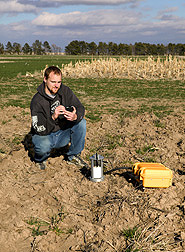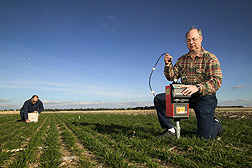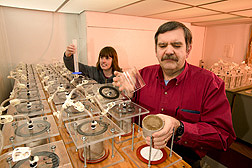Combining No-Till and the Right Rotations
Stores More Precious Precipitation
|
|
Scientists at the 102-year-old Agricultural Research Service Central Great Plains Research Station in Akron, Colorado, are in the 20th year of a major project determining which alternative crops farmers could use to eliminate—or at least reduce the frequency of—fallow fields.
The station serves an area that has twice the acreage of farmland that California has, including parts of Wyoming, Nebraska, and Kansas as well as Colorado. The long-term study, known as the “Alternative Crop Rotation” (ACR) project, provides data over four full 4-year rotation cycles, allowing scientists to average out the effects of different weather over the years.
Merle Vigil, an ARS soil scientist at Akron, and his colleagues constantly tailor the experiments in this project to meet the needs of farmers in the vast region the lab serves. The team meets annually with about 60 to 80 farmers to decide on needed research. The farmers are among the approximately 140 members of a farmer focus group.
The most diverse ACR project rotation uses wheat, corn, millet, and fallow in a 4-year cycle. It has the fourth highest economic return among the seven rotations being tested.
The project also includes 2- and 3-year rotations. All cycles include wheat, but they also include millet, corn, peas, sunflower, or triticale. The 2-year rotation uses the traditional 1 year of wheat, 1 year of fallow—done with both no-till and conventional tillage for comparison. The other cycles all use no-till.
Storing Precious Soil Water Is Key
Vigil gets farmers’ attention when he tells them that storing water in just the top inch of an acre of land—an “acre-inch”—is worth $25 to $30 an acre. Vigil, ARS agronomist David Nielsen, and ARS soil scientist Joseph Benjamin—both also at Akron—made this calculation by using 10-year average crop prices in equations they developed to relate crop yields to stored water levels. Four to six tillage passes to kill weeds result in a loss of 3 acre-inches of water over 14 months of fallow. Those six passes cost $24 to $48 an acre in fuel and labor costs. “Adding that to the cost of water lost, that’s $99 to $138 from your pocket,” Vigil tells farmers.
The scientists have shown that using no-till practices in the conventional wheat-fallow rotation can increase net farm income. They have also shown that by combining no-till and no-fallow, farmers can capture much more of the precious 14 to 18 inches of rain or snowmelt that may occur each year in various parts of the Central Plains. In the case of one of the most profitable rotations, no-till wheat-millet, farm net income could increase by as much as $1,300 a year compared to no-till wheat-fallow on the hypothetical 160-acre farm used for economic analyses.
Although less fallow is good, the other three best rotations (wheat-millet-fallow, wheat-corn-millet-fallow, and wheat-corn-fallow) also had fallow as part of the rotation. That shows that it may not yet be practical to totally eliminate fallow.
Since the prairie sod was first broken in the 1800s, Plains farmers have only been growing wheat every 2 years. They leave fields unplanted for 14 months or more, because there is only enough water from precipitation to grow a wheat crop every 2 years.
“The idea is to store precipitation in the soil during the idle months,” says Vigil. “That was a good idea then, but today it is not economically or environmentally sustainable for most soils in the region.” Fallow loses 65 to 80 percent of precipitation to evaporation. Besides wasting water, fallow causes a decline in soil organic matter, leaves soil susceptible to wind erosion, and gives low economic returns.
|
|
Irrigation on Steep Decline
Capturing more rainwater is essential in a region that is so dry that competing urban uses promise to reduce the area’s 9 million irrigated acres by about half a million within the next decade or two.
“Because no-till stores more water in the soil under crop residue, it permits increased cropping intensity from one crop in 2 years to three crops in 4 years—and in some cases, continuous cropping with no summer fallow,” Vigil says.
Growing alternative crops in rotation with wheat and continuously cropping when conditions are favorable increase the capture and use of precipitation.
To date, the experiments have shown that in addition to soil water saved and increases in yields and economics, there are substantial improvements to soil with alternative crop rotations. Maysoon Mikha, an ARS microbiologist at Akron, has found that the past 15 years of no-till and continuous cropping with reduced fallow frequency have had positive effects on soil structure and functioning.
Even with traditional wheat-fallow, no-till increased soil organic matter by 24 percent at the 0- to 2-inch depth and 14 percent at the 2- to 6-inch depth, compared with conventional tillage with the same rotation.
Ways To Save Even More Water
The project has shown that no-till’s value for storing precipitation in soil can be enhanced by changing harvesting equipment to leave even more residue on the soil surface. This includes use of a stripper header. The stripper header removes just the head of grain, leaving the rest of the plant standing to enhance precipitation storage and erosion protection. Traditional combine headers cut off most of the plant stalk with a sickle and then leave the stubble short.
Also, the scientists have recently shown that skipping one or more rows—rather than planting every row of a crop—conserves soil moisture and improves crop yields.
“We proved the value of stripper-header harvesting and skip-row planting in ancillary experiments and then made them part of the ACR project in recent years,” Vigil says.
Nielsen says, “Including crops such as millet and triticale, grown for forage instead of grain, reduces the risk of total crop failure from a lack of rainfall during the critical growth stages of grain crops.” He has found other ways to reduce the risks of drought, including estimating soil water in the spring to see if there is enough to warrant skipping fallow.
So What? Who Cares?
Vigil is famous with his colleagues for always making sure they can justify each research experiment by quickly and concisely answering, “So what? Who cares?”
Through careful research planned in cooperation with farmers and by adding newly successful techniques to the long-term rotation project—while dropping failures—they’ve answered these questions in dollars and cents and acre-inches of precious soil water saved, so Central Plains farmers really will care.—By Don Comis, Agricultural Research Service Information Staff.
This research is part of Soil Resource Management, an ARS national program (#202) described at www.nps.ars.usda.gov.
Merle F. Vigil is with the USDA-ARS Central Great Plains Research Station, 40335 County Road GG, Akron, CO 80720; (970) 345-0517.
"Combining No-Till and the Right Rotations Stores More Precious Precipitation" was published in the January 2011 issue of Agricultural Research magazine.









